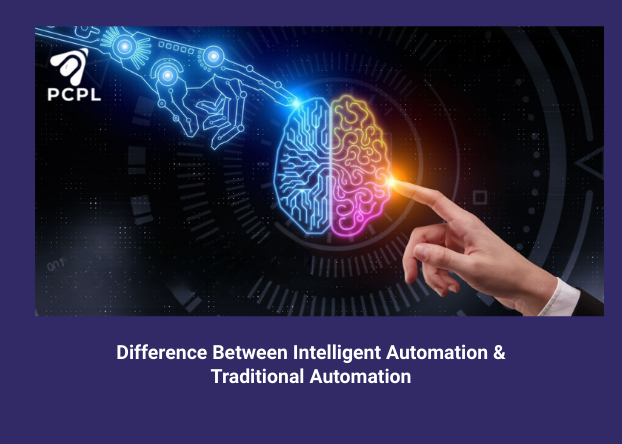
Difference Between Intelligent Automation & Traditional Automation
Intelligent automation (IA) and artificial intelligence (AI) are essential tools for any company planning to gain a competitive edge. These technologies are used in a variety of applications, such as automated chatbots that handle customer service and self-governing systems that predict customer purchasing habits.
AI and Process Automation
AI enhances process automation by introducing intelligence, leading to a greater business impact.
Unlike traditional automation methods like Robotic Process Automation (RPA) that follow predefined rules, AI enables systems to
- Execute complex tasks
- Understand intricate data
- Make informed decisions
- Learn from past results
AI uses data to analyze situations and determine the most effective course of action, injecting a new level of capability into automation.
AI’s Role in Process Automation
AI significantly boosts process automation by adding intelligence, which in turn creates a more profound business impact. While traditional automation methods, such as Robotic Process Automation (RPA), rely on following a set of predefined rules, AI allows systems to do more.
It empowers them to
- Handle complex tasks
- Comprehend complex data
- Make informed decisions
- Learn and improve from past outcomes
AI utilizes data to analyze situations and determine the most efficient path forward, thereby infusing a new level of capability into automation workflows.
To understand how AI enhances traditional automation, it’s essential to define Intelligent Automation (IA). IA moves beyond basic automation by integrating AI, RPA, data fabric, and other cutting-edge technologies. This combination allows businesses to transform their operations more effectively. Understanding the components of intelligent automation is key to seeing how these technologies collaborate to generate substantial business value.
AI and intelligent automation differ in their primary function and scope, with AI acting as a foundational technology that intelligent automation can use. Intelligent automation focuses on streamlining workflows and processes, while AI is about creating systems that can mimic human intelligence.
Intelligent Automation
Intelligent automation (IA) is a broad term for using various advanced technologies to automate and optimize business processes and tasks. IA focuses on automating repetitive, rule-based workflows to increase operational efficiency and accuracy. While it can leverage AI, IA is not a synonym for it.
The main components of IA are as follows
- Robotic Process Automation (RPA)- Software robots that automate structured, repetitive tasks, such as data entry or invoice processing.
- Business Process Management (BPM)- Tools that help manage and optimize complex business workflows.
- Integration with AI- Using AI technologies like machine learning (ML) and natural language processing (NLP) to handle unstructured data and make more intelligent decisions within the automated workflow.
Artificial Intelligence
Artificial intelligence (AI) is a field of computer science dedicated to creating machines that can simulate human-like cognitive abilities. Unlike IA, which is about automating tasks, AI is about enabling machines to “think” and learn.
Characteristics of AI are-
- Learning and adaptation– AI systems can learn from data and improve their performance over time without explicit programming.
- Problem-solving– AI can analyze information and solve complex problems, such as recognizing patterns in images or making strategic decisions.
- Broad applications– AI is the main technology used in various applications, including medical diagnosis, self-driving cars, and language translation.
The Relationship Between AI and Intelligent Automation
While distinct, AI and intelligent automation have a symbiotic relationship. IA can be seen as the application of AI and other technologies to a specific business goal- process automation. Think of AI as the engine and IA as the entire vehicle designed to transport goods (i.e., automate tasks). AI provides the intelligence, such as the ability to interpret data, while intelligent automation uses that intelligence to execute a complete, end-to-end process. For example, an IA system might use an AI model to read and understand customer emails, then use RPA to automatically respond or route the email to the correct department.
Robotic Process Automation (RPA)
RPA is a technology that makes use of software robots, or “bots,” to automate repetitive and rule-based tasks. RPA bots work by mimicking the actions of a human user within digital systems, such as navigating applications, entering data, or extracting information. RPA frees up human employees to focus on more complex, and strategic work that requires critical thinking and creativity by handling these mundane, high-volume tasks. This automation not only boosts efficiency but also significantly improves the accuracy of processes by eliminating human error.
Low-Code Development Platforms
Low-code development platforms are tools designed to streamline the creation of applications and intelligent automation solutions. These platforms use visual interfaces as well as pre-built components, allowing users to build complex workflows and applications with minimal traditional coding. The low-code approach accelerates the development lifecycle, making it easier for business users to collaborate with IT departments in building and deploying solutions. This approach democratizes the development process and allows organizations to more quickly operationalize intelligent automation across various business processes.
AI and traditional automation tools like Robotic Process Automation (RPA) are not mutually exclusive; rather, they are complementary technologies. While traditional automation relies on rigid, predetermined rules, AI provides the intelligence to handle complex, unstructured situations, thereby enhancing the capabilities of automation.
AI as an Enhancement to Traditional Automation
Traditional automation tools are great at performing repetitive, rule-based tasks with speed and accuracy. For example, an RPA bot can flawlessly process thousands of invoices as long as they follow the same format. However, these tools lack the ability to handle exceptions or unexpected situations that fall outside their programmed parameters.
This is where AI comes in. AI’s core strength lies in its ability to learn from data, recognize patterns, and make intelligent decisions. With the integration of AI, an automation system can do the following
- Handle Unstructured Data– An AI-powered system can read and understand an email, a document, or an image and extract relevant information, even if the format changes.
- Adapt to New Situations– Unlike a traditional bot that would fail if a process step changed, an AI model can be trained to recognize the new pattern and adjust the workflow accordingly.
- Make Predictions and Decisions– AI can analyze historical data to predict future outcomes and make proactive decisions, such as flagging a suspicious transaction or optimizing a supply chain route.
AI gives traditional automation the “brain” it lacks, allowing it to move beyond simple, rule-based tasks and handle more complex, cognitive work.
Discriminative vs. Generative AI
Within the field of artificial intelligence, there are different approaches, with discriminative and generative AI being two key types that offer distinct capabilities.
- Discriminative AI– This type of AI is designed to classify or predict an outcome based on given input data. It “discriminates” between different categories. For example, a discriminative model can tell you if an email is spam or not, identify a cat in a photo, or predict a customer’s likelihood of making a purchase. It studies the relationship between features and labels to make a prediction.
- Generative AI– In contrast, generative AI is designed to create new content that is similar to the data it was trained on. It “generates” something from scratch. Examples include creating realistic images from a text prompt, writing human-like prose, or composing music. Large Language Models (LLMs) are a well-known type of generative AI that can produce new text by predicting the next word in a sequence.
Both discriminative and generative AI can be integrated into intelligent automation systems. A discriminative model might be used to classify customer support tickets, while a generative model could be used to draft a response. This showcases how different forms of AI can work together to enhance and extend the capabilities of traditional automation.
The Combination of AI and Intelligent Automation
To succeed with intelligent automation, IT leaders should view AI and intelligent automation (IA) as complementary technologies rather than as separate tools. IA streamlines processes and automates tasks, while AI provides the cognitive capabilities, like learning and decision-making, that make these automated systems smarter and more effective.You can build systems that not only perform repetitive tasks but also adapt to new information by combining them, thus leading to more efficient and dynamic business operations.
Important Takeaways for IT Leaders
To successfully implement these technologies and drive digital transformation, IT leaders should focus on a few key areas as follows-
- Focus on Business Impact– Don’t just automate for the sake of it. Use AI and IA to solve specific business problems, such as improving customer service, reducing operational costs, or speeding up product delivery.
- Start Small and Scale– Begin with pilot projects in a specific department or process. This allows your team to gain experience and demonstrate value before scaling the solution across the entire organization.
- Invest in Talent– The success of AI and IA initiatives depends on a skilled workforce. Invest in training your current employees and hire talent with expertise in data science, machine learning, and automation.
- Promote Collaboration– Encourage the collaboration between IT and business units. IT can provide the technical expertise, while business leaders can offer insights into the processes that need improvement, ensuring the solutions you build are both effective and relevant.
References
https://www.linkedin.com/pulse/intelligent-automation-beyond-traditional-rpa-comprehensive-3qzuf/
https://www.automationanywhere.com/rpa/intelligent-automation-vs-rpa
